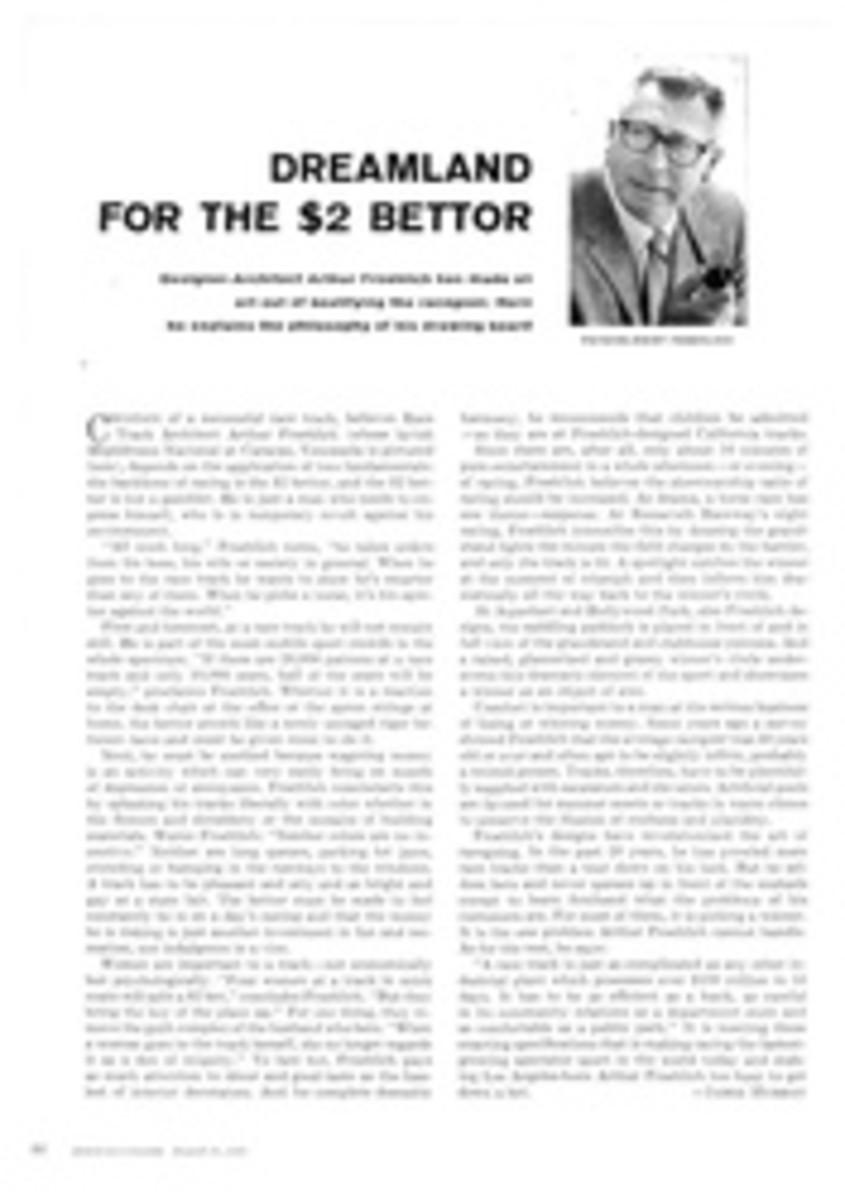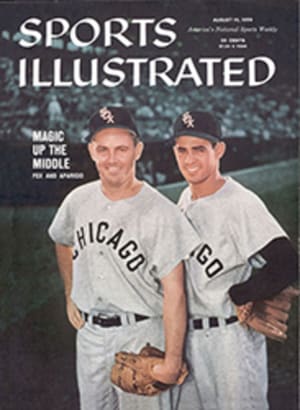
DRAMA AT MINNEAPOLIS IN WIND AND RAIN
Beginning in the heavy heat of Minneapolis last week and ending in a swirl of rain and wind and suspense, the Professional Golfers Association held its 41st annual championship and the second to be run under stroke-play rules. As the week-to-week tournaments on the professional circuit go, it was splendid theater. Jerry Barber, a 43-year-old teaching pro at the Wilshire Country Club in Los Angeles, came up to the 70th hole needing par figures of 3-4-4 for a total of 276 and victory. Bob Rosburg, who outweighs the 5-foot 5-inch, 134-pound Barber nearly three to two, had already closed out with a 3-under-par 277, and that was all Barber had to beat to win the first major tournament of his career.
On the par-3 70th, Barber pushed his tee shot into a bunker bordering the green, recovered to within 15 feet of the pin and sank his putt to hold position. On the par-4 71st, he pulled his second into a bunker to the left of the green, played out weakly and failed to sink his very long approach putt.
Now with the stiff wind whipping at his trousers and the rain spotting his horn-rimmed spectacles, Barber needed a birdie on the par-4 72nd for the victory that nearly everyone in the immense Sunday crowd of 12,000 wished him. But again he pulled his second shot into a bunker on the left of the green and this time played his wedge too strongly, some 15 feet past the pin. His second straight bogey left him one stroke behind Rosburg, a blond, portly and also bespectacled Californian who had been having his own agonizing time in the clubhouse waiting for Barber to make or break.
A onetime golfing star at Stanford, the 32-year-old Rosburg, whose figure—like that of Billy Casper, the U.S. Open champion—may set physical fitness back a decade or more, has never before won a major golf championship. Yet his consistency with, or in spite of, his baseball grip and dufferlike swing is extraordinary. Last year, even without scoring any victories on the tour, he won the Vardon Trophy for the lowest average score per round: 70.11. This year it was he, along with Mike Souchak, who supplied the drama at the Open as he slugged his way through the high winds of the final day and almost caught Casper. Bad weather seems to agree with Rosburg, as befits a son of northern California. His final round of 66 in the PGA was one of the truly notable finishing spurts in the golfing records.
Despite the excitement which was stimulated by last week's renewal, a great many observers complain, and rightly, that the PGA has simply stuck another 72-hole tournament into an already crowded schedule and said, "This is our championship." Well, this could be the last year that that particular charge can be made. Still another change is in store.
"The only real weakness in this whole setup as it now stands," said Ed Carter, the PGA's 52-year-old tournament director, a hefty, bearish, energetic man who used to buck the line as a fullback at Northwestern, "is that it lacks a truly different format. Well, I personally think that it should be made into a five-day, 90-hole championship. I'm going to make this recommendation to the PGA's executive committee when they meet in December, and there's a good chance that they'll accept my recommendation and install the new format next year.
"We're putting it on better and better courses each year," he continued, "and within a couple of years I think that the attendance will be up 50% and the prize money around $75,000. We're not deliberately aiming to take a crack at the Open and the Masters, but since this is a professional tournament promoted by professionals there's no reason why it shouldn't be the best."
The professional players themselves, a hard-working group of athletes who can be very truculent at times, would like nothing better than to see their own PGA championship replace the Open as golf's No. 1 prestige event. Many of the leading circuit regulars are even threatening to band together and boycott the Open, but with $12,000 in prize money currently being offered to the winner there is little chance that the threat has any bite to it. They complain that the qualifying system for the Open, though improved this year, is unfair to players who have proved themselves time and time again through the course of the year but then fail to qualify because of one mediocre round. They add that Open courses are often tricked up to make scoring unnecessarily difficult, i.e., that the fairways are too narrow, the bordering rough too deep, the greens too hard and fast, and the holes cut into the greens at locations that punish a slightly errant shot unfairly. Their strongest protest, and one that has considerable merit, is that the pairings for the Open's final day of 36 holes don't make any sense. Here the tournament leaders are sent off at widely separated times of day and therefore might be playing through different wind and weather conditions. Worse yet, a strong challenger for the lead often finds himself struggling along through his final round with an amateur who is some dozen strokes out of contention. The PGA, on the other hand, bunches its leaders together and sends them out last so that incentive is maintained and playing conditions are as identical as possible.
"I see this tournament as passing the U.S. Open in stature within the next five years," said Ed Furgol, the 1954 Open champion. "Our men know what they're doing."
What Furgol meant is, quite simply, that the PGA knows how to make money. This, fortunately, is not the USGA's prime concern. They could certainly stretch their Open over four days, at 18 holes a day, and increase the gate receipts by 30% to 50%. But their main interest is in preserving a unique and true championship event. As a four-day affair it could maintain its place as one of the world's most important sports events only by tremendous, annually increased doses of prize money.
This is the problem now facing the PGA in the conduct of its championship. Even while offering a record $50,000-plus in total prize money this year, their tournament is merely another flower in a blossoming garden of $50,000 events. The Las Vegas Tournament of Champions with $10,000 for the winner, the Open with $12,000 and the Masters with $15,000 still offer more money, and all are played on more interesting and more difficult courses. What the PGA must do is develop a unique and legitimate way of determining its champion, and Ed Carter's five-day plan seems just a method of extending the present agony. However, the day of a match-play championship is definitely over, since the PGA stoutly insists that it lost money using that formula.
Whatever else this year's PGA may or may not have been, it could hardly have provided a more exciting contest, so filled with dramatic contrasts. No tournament in the history of major competition has ever equaled or even approached this one for the number of players crowded at and around the leading position after the first round. When 42-year-old Chuck Klein, a squat driving-range and par-3 golf course owner from San Antonio, stumped up the short hill to the 18th green in the late afternoon and then two-putted from the extreme back edge, no less than nine golfers had scored 1-under-par 69s to share first place. There were also nine players clustered one stroke off at 70, eight at 71, 15 at 72, 14 at 73. Only five strokes separated the leading 76 players. To carry this statistic a step further, a narrow blanket of only 10 strokes covered all but 27 of the bulky field of 174 starters.
This unprecedented grouping of scores told a great deal about the course. While not difficult in other respects its greens, hard and small, made it impossible to shoot runaway rounds in the middle or low 60s without playing exceptional golf. In their weekly circuit events the pros are accustomed to well-watered greens that are as soft as custard pudding. On these courses they can bang the ball straight for the cup, confident that it will sit where it hits.
The testing conditions made two of last week's rounds all the more remarkable. One was Jerry Barber's new course record of 65 on the second day. The other was Bob Rosburg's closing rush to victory.
PHOTO
WINNER ROSBURG'S ODD GRIP AND SWING CAUSE HIM NO TROUBLE
PHOTO
VETERAN Jerry Barber tells the press how he shot his new course record of 65.

